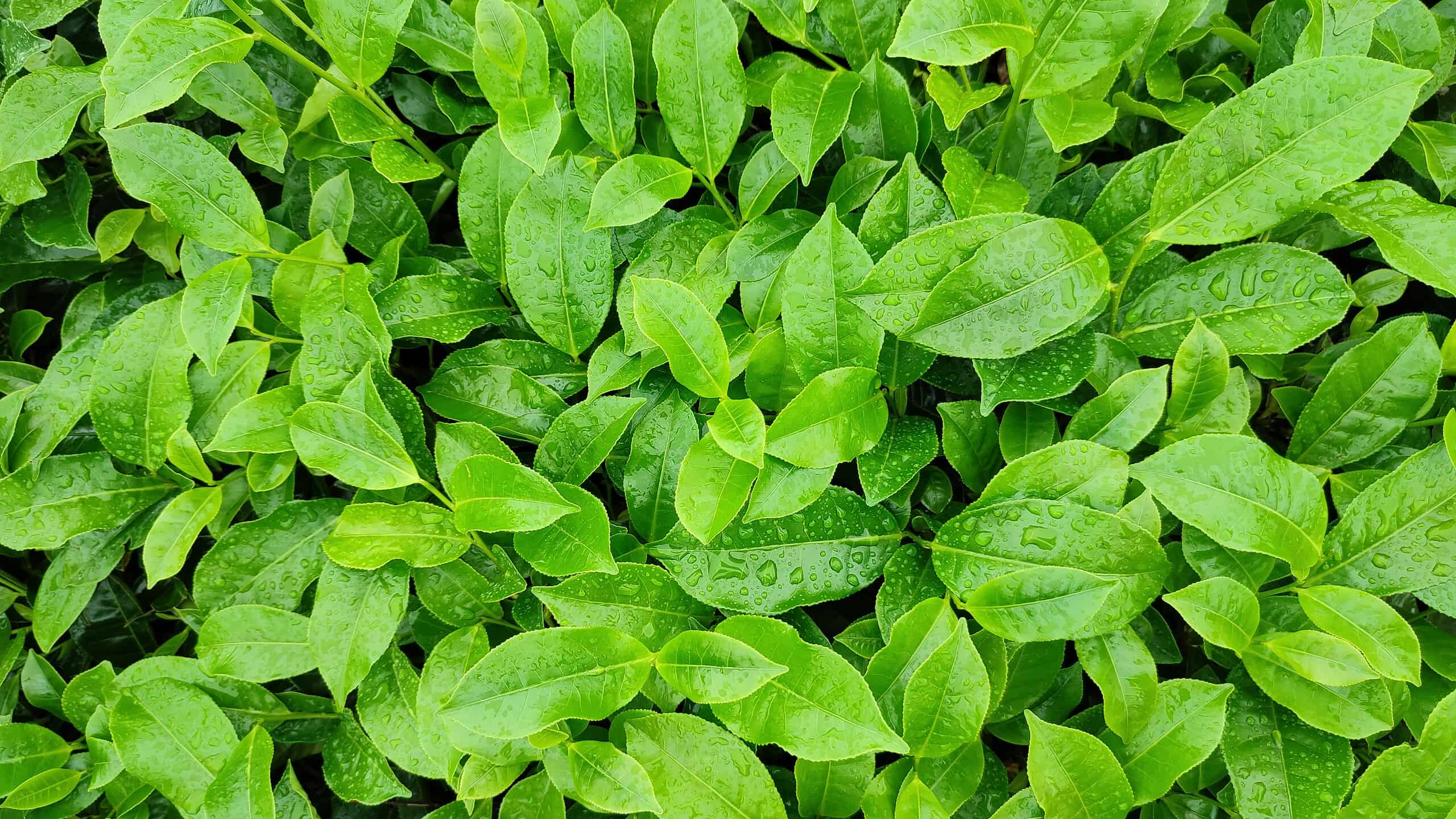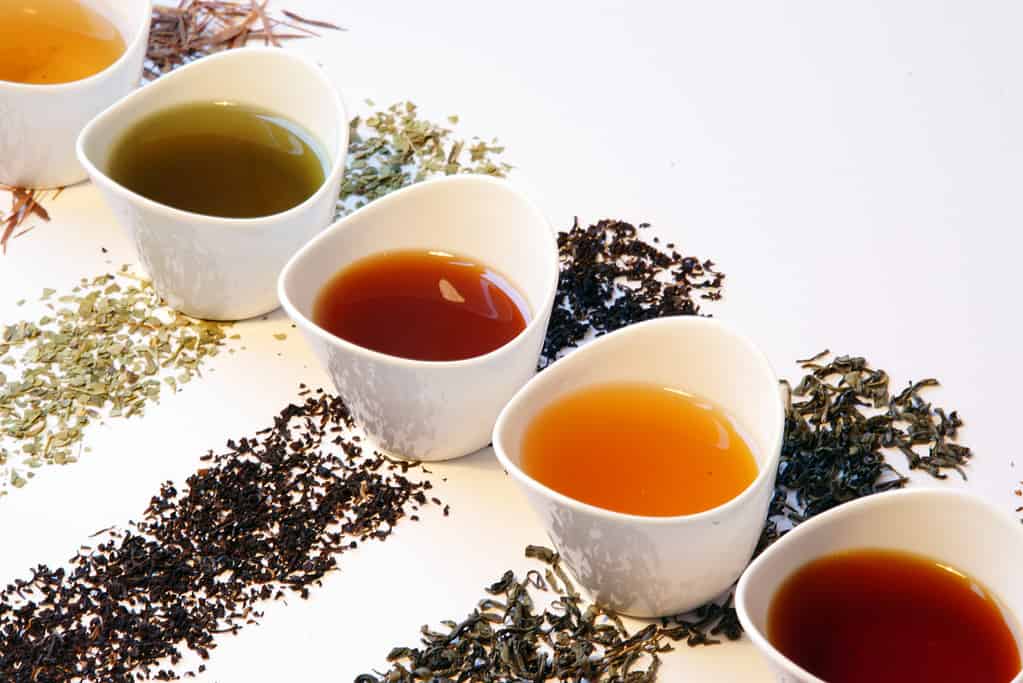
Each cup of tea and tea leaf type produces slightly different colors and flavors.
©cirquedesprit/iStock via Getty Images
Have you ever grown camellias in your garden? If so, you may be somewhat familiar with the genus of plant that produces your favorite cup of tea. While technically, the tea plant doesn’t produce every single cup of tea, as there are jasmine teas, rooibos, and herbal teas out there, it does produce many of the most popular ones in the world.
If you’ve ever had a cup of black, white, or green tea, you’ve tasted this plant. Though the flavor profiles for all these teas are vastly different, as well as the colors and appearance of the leaves, they all come from the same plant.
To learn how one plant manages to produce so many flavors, as well as the history of the tea plant, continue reading below.
What Is the Tea Plant?
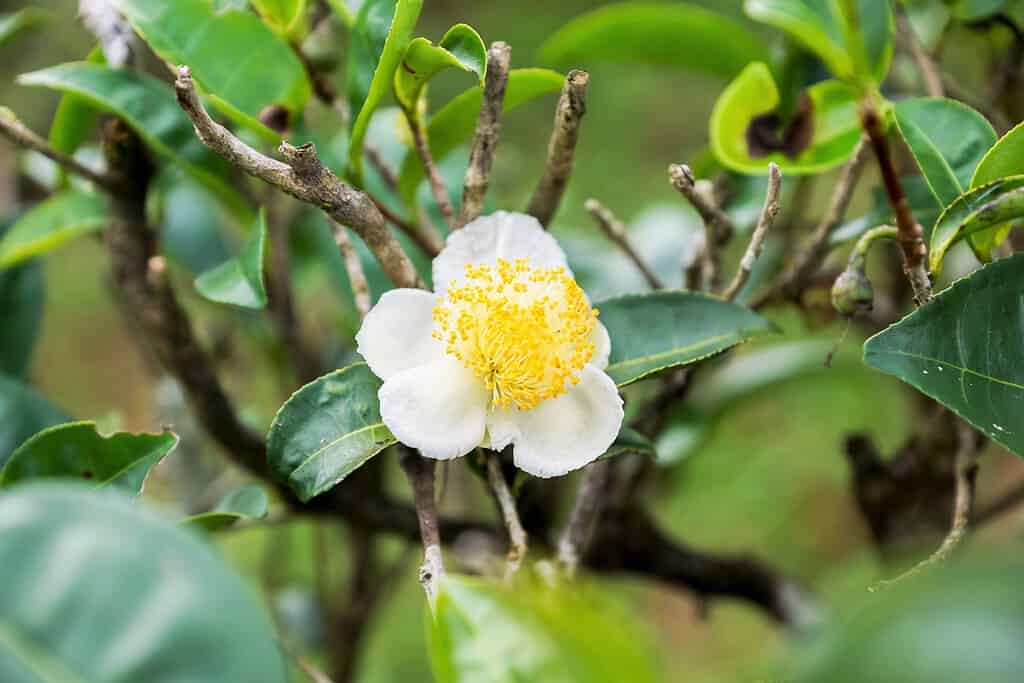
The flowers of the tea plants are small and beautiful but aren’t the main focus of the plant.
©Tharnapoom Voranavin/Shutterstock.com
The tea plant comes from the Camellia plant genus. There are about 250 plants that fall into this genus. Its scientific name is Camellia sinensis.
Though these plants are often small, they can reach up to 30 feet in size. They also grow flowers. However, the flowers aren’t as large and elegant as some other Camellia plants are. They are about four centimeters wide and white with a bright yellow center.
The tea leaves are harvested when they are young and delicate. Tea grows throughout most of the year until temperatures dip below 50 degrees Fahrenheit. This means that young tea leaves are harvested throughout spring, summer, and fall.
The Two Varieties
Technically, as of now, there are 112 accepted varieties of the tea plant, each officially approved and producing slightly different flavors or textures. In total, there are thought to be 1,500 different varieties of tea plants throughout the world. However, the two main tea varieties are still the Camellia sinensis var. sinensis and Camellia sinensis var. assamica. Additionally, almost all of the varieties of tea originally come from these two plants.
Interestingly, it’s shown that at the beginning when humans started to grow and create their varieties of Camellia sinensis, there were three main variations in different parts of the world. This hints at the fact that people started growing and adapting tea plants to suit their own domestic purposes three different times.
Unfortunately, the third variation isn’t used, but the other two, C. sinensis var. sinensis and C. sinensis var. assamica, are still widely used and make up a majority of the tea people drink to this day.
Var. sinesis
The first variety, var. sinensis has smaller leaves than the other. This makes for more delicate tea. It also does better in colder temperatures and higher elevations. Because plants grow slower in colder temperatures, var. sinensis grown at higher elevations is said to have a deeper and richer flavor.
Var. assamica
On the other hand, var. assamica is a little more delicate. It doesn’t handle high elevations or cool temperatures as well. The exception to this is Darjeeling. This tea grows at elevations starting at 2,000 feet. It’s said to have the most delicate flavor of any tea, and it has such a unique flavor that many people skip milk and sugar.
The other kind of tea made by var. assamica is Assam tea. This is a very strong and dark tea. It’s used in many breakfast teas as it’s strong enough to help people wake up. They are also made in larger batches, so that every cup of tea has the exact same flavor, unlike in China, where tea is made in small batches and each batch may have a slightly different flavor.
Where it Grows
Most tea comes from China. The tea that comes out of China accounts for 42.6 percent of the world’s tea. The reason why this country produces so much tea is because China is where the tea plant grows naturally. Specifically, in South-Central China and Southeast China.
Now, tea plants are grown in a range of countries. Most of them are still in Asian countries, but plants are now also grown in areas of the world like Ethiopia and Argentina.
What Cup of Tea Comes From the Tea Plant?

A cup of tea is good for you, and green tea is said to be the best.
©kuppa_rock/iStock via Getty Images
It’s estimated that over three million tons of tea are harvested every year. In Britain alone, citizens annually enjoy over 62 billion cups of tea. Tea is so popular globally that the tea market is worth just under $50 billion.
Most of this tea comes from one of the two Camellia sinensis varieties. C. sinensis var. sinensis is used for teas such as green tea and black tea. The C. sinensis var. assamica is used for Assam, or Indian black tea.
The best tea leaves that are young and delicate go on to become matcha. The rest of the tea leaves are separated. They undergo various processes and levels of oxidation to turn into almost any cup of tea including black, oolong, green, white, and Pu-erh tea.
Oxidation Methods for Each Tea
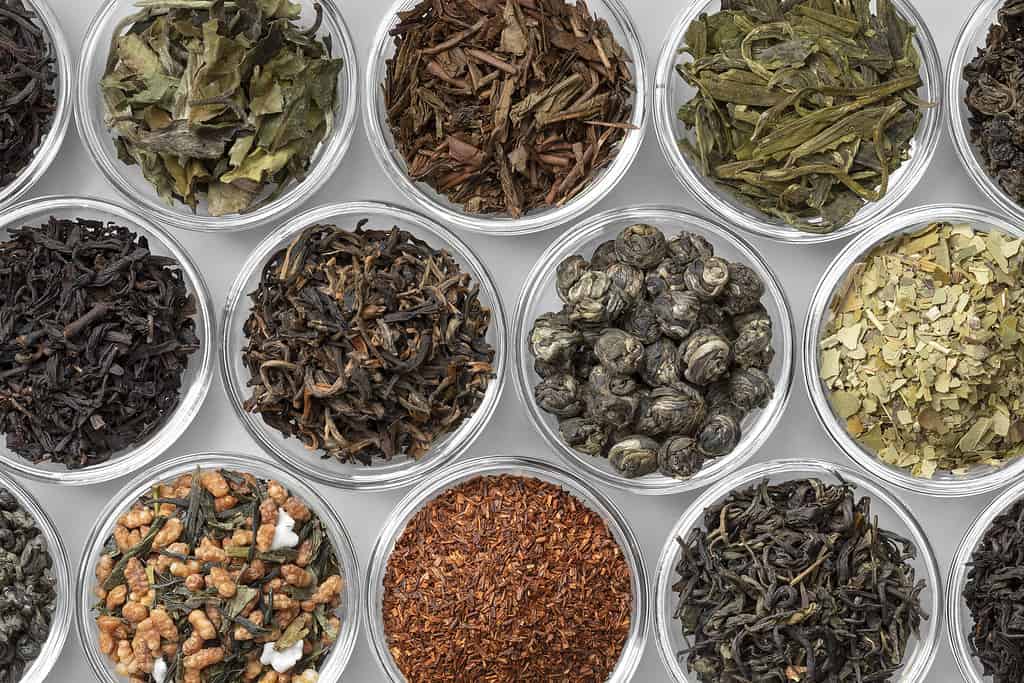
Many different kinds of teas come from the tea plant, though they look different thanks to their different oxidation methods.
©PicturePartners/iStock via Getty Images
Each tea has slightly different brewing methods that create its unique flavor and color. Oxidation levels, or fermentation in one case, are responsible for the different depths of flavor.
Black Tea
Black teas are fully oxidized. They are left out in the open air to dry out and oxidize. During the process, the leaves are broken up. This exposes more of the leaves to air and allows them to darken fully. Usually, when brewed, these teas are a deep red or amber color due to the high level of tannins in the tea.
Black tea is often hearty and robust and is the best tea to use with milk and sugar. English Breakfast, Assam, and Earl Grey all contain black tea.
Green Tea
Green teas are mostly not oxidized. Instead, they are heated up in a process known as “killing the green”. The heating process is most commonly frying or steaming. It stops green tea from oxidizing more. The leaves are often still green when used for making tea.
When brewed, the water is often a light green or brown color. The flavor of green tea is much more mild and grassy than the flavor of black tea.
Pu-erh Tea
Pu-erh tea is a little different from other teas on this list. Instead of undergoing oxidation, the leaves undergo fermentation. This means, that instead of being exposed to air to dry and break down, they experience microbial activity. This fermentation process can take several years.
The longer the tea is fermented, the more of the distinct rich and earthy taste the tea has. The leaves are often packed together in a brick or cube. When you brew the tea, you break off a portion of the brick and brew it.
Oftentimes, the first brew is very strong and bitter, so it isn’t often drunk. You can brew the same leaves several times. The flavor will get lighter and the taste will change as you go on.
Oolong
Oolong is another tea that’s heavily oxidized, though not to the same level that black tea is. Unlike black and green tea, there’s no set level of oxidation for oolong teas. Their oxidation process can stop anywhere between green and black tea levels.
Because of this, every oolong tea tastes a little different. Additionally, instead of being broken up, the tea leaves are often rolled into tight balls. As the tea steeps, the leaves unfurl. Because of this, it’s common to use these leaves more than once as they release different flavors with each brew.
White Tea
White tea is made up of the buds and tips of tea plants, instead of the young leaves. They aren’t left out to oxidize like other teas, but they still undergo a little oxidation as they are dried. These teas are often very light in color, low in caffeine, and have a bright, but delicate, floral flavor.
Matcha
You might expect matcha, a type of green tea, to have similar flavors to regular green tea but there are some differences. Matcha is made only from the finest of leaves. They are not oxidized but steamed right away to stop the process. Then, they are allowed to dry after.
Eventually, they will be ground into a fine powder. This powder is a bright green. It goes directly into your drink, without the need for a bag or a sieve to hold the leaves. The taste is very grassy, with hints of bitterness and nuttiness. The tea is often used for ceremonies but has become a popular drink to enjoy alongside other teas as well.
The History of Your Favorite Cup of Tea
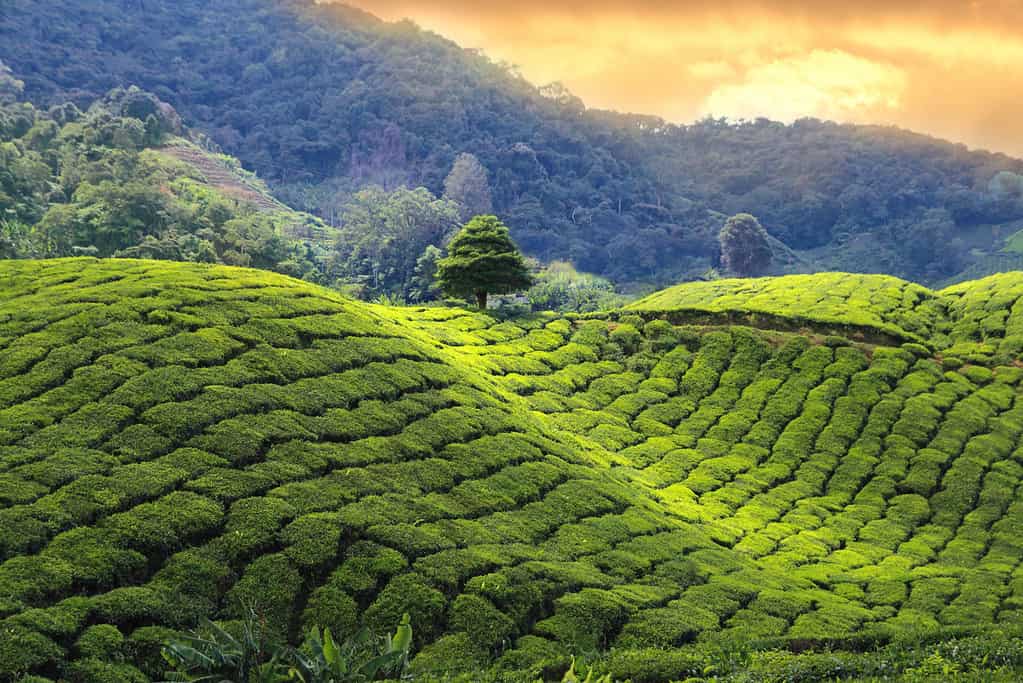
Tea plantations are checked at least once a season to ensure the youngest and best tea leaves are chosen.
©nevarpp/iStock via Getty Images
Tea wasn’t always used for drinking. Even now, the tea plant is used in several different ways.
Originally, the tea plant was used as a type of medicine. It was thought to help with a wide range of illnesses. While scientists haven’t verified all the claims, it has been shown that tea does reduce the risk of many diseases and reduces the toxins found in the body.
When it comes to tea finally being brewed as a beverage, the story goes that it first happened in 2737 B.C.E. An emperor was boiling water while outside in his garden. While the water boiled, leaves from the tea plant fell into the pot. When he tried the tea, he found it was quite delicious, and the drink quickly spread.
However, the first to drink tea regularly were the Buddhist monks. They found the caffeine in the tea plant helped them to meditate. Though tea eventually spread to the rest of the world, China kept its growing practices a closely guarded secret.
Exposing Tea Brewing Methods
When Britain started to become tea lovers, they didn’t like the idea of having to rely on China. The East India Tea Company sent a botanist to China to learn their secrets. He managed to steal over 30,000 specimens of the tea plant, as well as information about how China oxidized and harvested the tea leaves. Because of this botanist, the knowledge of making tea is available to the whole world.
About the same time this botanist smuggled out tea plants from China, another botanist, also employed by the East India Tea Company, learned about the teas in India. Because both these botanists worked hard to gather up the tea plants and learn the oxidation methods, tea is now enjoyed and produced around the world.
China and India are still the two major producers of tea. India’s tea doesn’t make it as far globally, however, as 70 percent of all tea brewed in India stays in the country and is used by the people that live there.
Thank you for reading! Have some feedback for us? Contact the AZ Animals editorial team.

